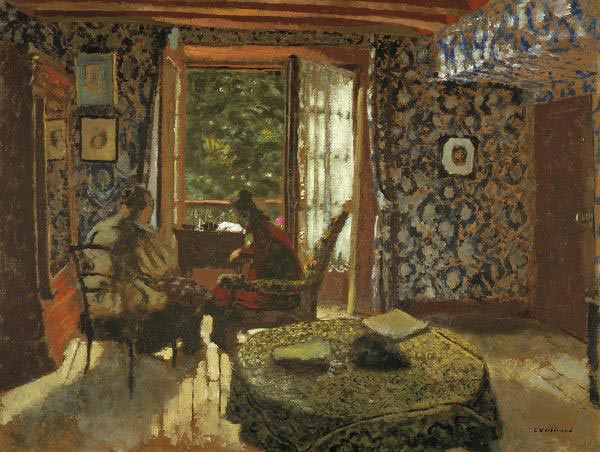| Édouard Vuillard | |
|---|---|
 |
|
| Born | Nov. 11, 1868 Cuiseaux, Saône-et-Loire, France |
| Died | June 21, 1940 (at age 71) La Baule, Loire-Atlantique, France |
| Nationality | French |
| Field | Painting, printmaking |
| Works | View Complete Works |
Édouard Vuillard (1868-1940), was raised in Cuiseaux, France. The son of a retired ship’s captain and a dressmaker, he was part of the art movement known as Les Nabis, whose members included painters like Pierre Bonnard. Les Nabis emphasized works with vibrant colors and lines and forms that echoed the shapes found in nature. They were influenced a great deal by the artist Paul Gaugin.
Early Career
Vuillard studied at the Lycee Condorcet till 1885. Later, he moved into the studio of Diogéne Maillart with his friend Ker Xavier Roussel. After this training, Vuillard, after some set-backs, was finally admitted into the Ecole des Beaux-Arts. Vuillard was part of the Nabis by 1890, and exhibited with his fellow artists at the Barc de Boutteville. He also designed programs and theater sets for the Théâtre de l’Œuvre.
By the end of the decade, Vuillard had traveled around the south of Europe, especially in Italy and Spain. He also traveled through Brittany and Normandy. He met the Natanson brothers, who founded La Revue Blanche, and published some of his graphics in their publication. The Revue Blanche was also famous for publishing the works of Bonnard, Vuillard’s fellow Nabis, and Toulouse-Lautrec.
 The Natansons also encouraged Vuillard to help decorate the houses of several prominent people, including Mme. Desmarais and Alexandre Natanson. He also worked on the Théâtre des Champs-Élysées. Indeed, Vuillard received commissions like these till shortly before his death. They include Geneva’s Palais des Nations and Paris’ Palais de Chaillot. He often collaborated on these commissions with other artists like Bonnard, Maurice Denis, and Roussel.
The Natansons also encouraged Vuillard to help decorate the houses of several prominent people, including Mme. Desmarais and Alexandre Natanson. He also worked on the Théâtre des Champs-Élysées. Indeed, Vuillard received commissions like these till shortly before his death. They include Geneva’s Palais des Nations and Paris’ Palais de Chaillot. He often collaborated on these commissions with other artists like Bonnard, Maurice Denis, and Roussel.
The turn of the century found Vuillard continuing to exhibit his works at prestigious galleries like the Salon des Indépendants, where his paintings were on display in 1901, and the Salon d’Automne, which exhibited his work in 1903.
Painter of the Domestic
Vuillard lived most of his life with his mother, and his paintings, whose subject matter is largely domestic, reflect this. Many of his works show women at the breakfast table, or sewing, or sleeping or sitting and contemplating. In this way he’s much like Bonnard, though Bonnard often used his wife Marthe as a model.
 Vuillard’s After the Meal recalls Bonnard’s The Dining Room in its use of warm, vibrant color and light, though Vuillard’s brushstrokes are far looser and more Impressionistic, and his technique is rougher. Vuillard also has a gentle sense of humor, as can be seen in his Octagonal Self-Portrait. Here the artist, with his yellow hair and red beard, is slightly off center in the frame, and glances out at the viewer with a sense of surprise, as if he’s been caught in the act of moving out of his own portrait.
Vuillard’s After the Meal recalls Bonnard’s The Dining Room in its use of warm, vibrant color and light, though Vuillard’s brushstrokes are far looser and more Impressionistic, and his technique is rougher. Vuillard also has a gentle sense of humor, as can be seen in his Octagonal Self-Portrait. Here the artist, with his yellow hair and red beard, is slightly off center in the frame, and glances out at the viewer with a sense of surprise, as if he’s been caught in the act of moving out of his own portrait.
The pastel work Biahna Duhamelin “Miss Helyett” shows a smiling girl in a purple outfit dancing against a sun-yellow background. His Girls Walking shows two young girls from behind, arms linked, as they take a stroll through an autumnal park. The artist draws special attention not just too the fallen leaves at their feet, but the striped stockings that peek out between their dress hems and the tops of their boots. One girl’s stripes are vertical, the other horizontal.
Vuillard’s latest exhibit was at the Jewish Museum at New York. Édouard Vuillard: A Painter and His Muses, 1890-1940, ran from May to September 2012. He died in La Baule, a pretty, seaside resort in Brittany, at the age of 71.